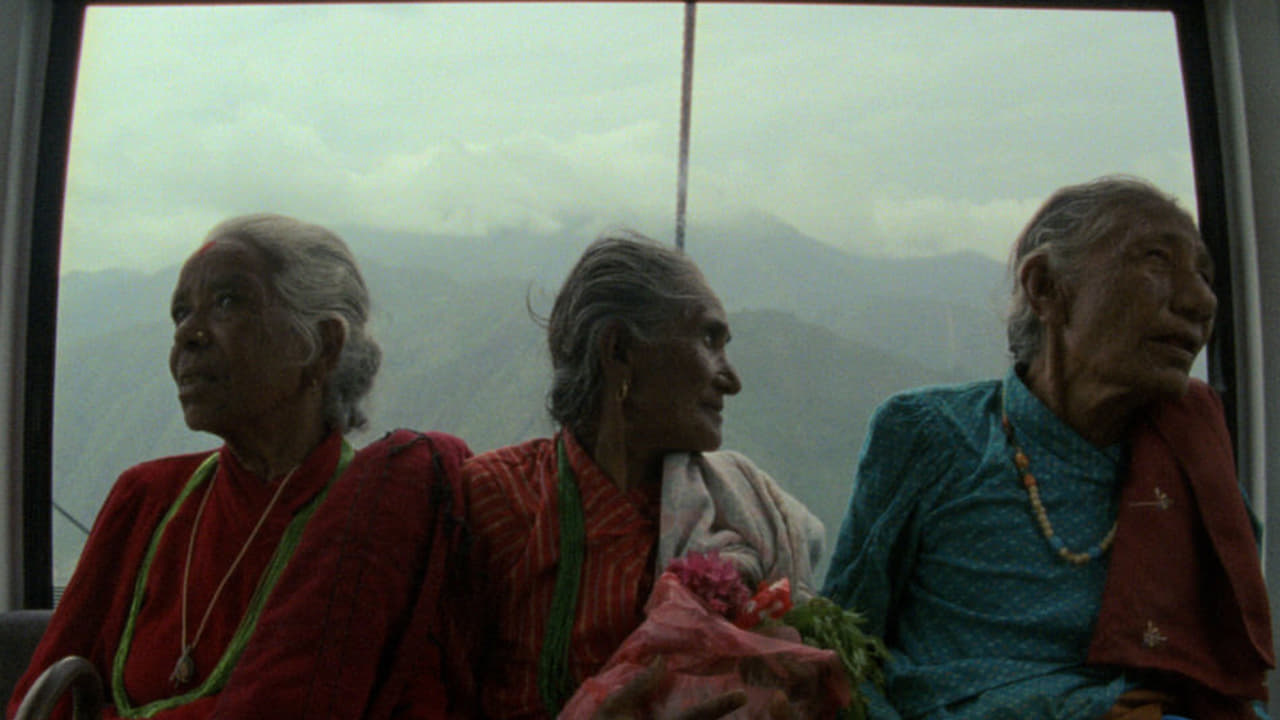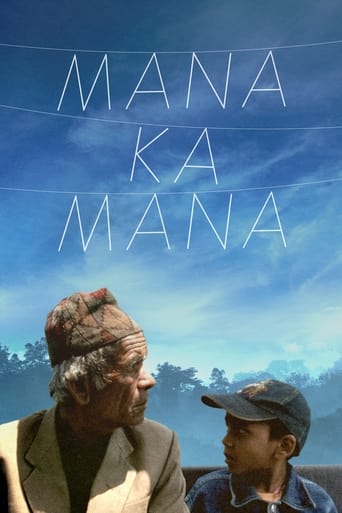

Although it has its amusing moments, in eneral the plot does not convince.
... View MoreA movie that not only functions as a solid scarefest but a razor-sharp satire.
... View MoreTrue to its essence, the characters remain on the same line and manage to entertain the viewer, each highlighting their own distinctive qualities or touches.
... View MoreGreat movie. Not sure what people expected but I found it highly entertaining.
... View MoreManakamana is a spiritual experience. True, it is filmed inside a cable car that is transporting its passengers to a temple in the foothills of the Nepalese Himalayas dedicated to Manakamana, the Hindu goddess of good fortune. However, the ethereal experience of the film does not only belong to the passengers but also to us, the audience, the voyeurs. The work is filmed in 16mm and records 11 trips. This gives the audience the depth of time to watch, listen, observe and internalize these pilgrims. In this hypnotizing act of looking, we become pilgrims ourselves, enthralled in a simultaneous internal and external exploration of landscapes. Stephanie Spray and Pacho Velez are the filmmakers behind this work. Stephanie Spray is a filmmaker, phonographer and anthropologist who has been working at the Sensory Ethnography Laboratory at Harvard University since 2006. Her work exploits different media to explore the confluence of social aesthetics and art in everyday life. Since 1999 she has spent much of her time in Nepal, roaming its mountains; studying its music, religion and language; and making films. Pacho Velez's work sits at the intersection of ethnography, structuralism and political documentary. Though shot in different countries, using distinct formal strategies, his films share a preoccupation with local responses to broad changes wrought by globalisation. He teaches at Bard College.These two influences are reflected in the situation of the work geographically, both on a temporal and otherworldly level. The nuances of culture, gender, nationality, age, and marital status are all revealed to us on this journey. As a trio of elderly women, a pair of young American tourists, a husband and wife, three young men, two musicians and a small herd of goats each take their trip above the rich and verdant landscape, a character study ensues. Each entity is occupying space that someone else previously did. However, even though they may be travelling along the same route and may have the same destination, they are all worlds apart. One of the things that I will carry forever with me of this film, is the feeling that not only was I watching these people but they were watching me too. The camera lens felt like a two way portal. That feeling of being connected to another time, space and entity engendered feeling of meditative peace and tranquility. It sparked a complex internal dialogue that could not be translated with words.This film is probably the furthest thing away from Hollywood that I have seen, at least in a long time. It is breathtaking in the boundaries that it challenges and transcendental in its quiet ambition.
... View MoreIf life is up and down with a few bumps along the way, what better representation is there than a cable car's ride up and down a mountain? This particular cable car ride takes place in the riveting documentary Manakamana, a ride that brings passengers, both foreign and local, to the Manakamana Temple in the Gorkha district of Nepal. Consisting of ten-minute segments with extra time taken to show a darkened terminus building, the film is a portrait of nine different families and friends visiting a shrine to the Hindu goddess Manakamana who, it is believed, makes wishes come true.Stephanie Spray and Pacho Velez (Leviathan) of Harvard's Sensory Ethnography Lab, with their 16mm camera anchored to the floor, simply filmed people going up to the 17th century temple, as well as those on their way down (one trip is a voyage with four goats tied together being brought to the temple to be sacrificed). Out of thirty-five trips shot by the filmmakers, eleven were selected and the film was edited over a period of eighteen months. Spray, who has lived in Nepal since 1999 knew some of the passengers and this may account for the fact that conversations are natural and relaxed, even though I'm sure they couldn't help being aware of the camera.The first trip is silent as an elderly man sits next to his grandson, occasionally gazing at the passing scenery as the car climbs higher and higher. When conversations do begin after about twenty minutes into the film, people talk about their families, their religion, the way it used to be, a trail that is no longer used, and the replacement of thatched roofs by slate and slate roofs by tin. Many comment on the beauty of the surrounding hills and the sal trees, said to be favored by Vishnu in the Hindu tradition and under which Buddha is supposed to have been born.Three older women chant their message of worship to the goddess while, in a sharp cultural shift, three long-haired young men talk about their rock band and take pictures of themselves from their mobile device. Additionally, there are two young women who speak English, one sounding like an American, the other Nepalese. We are also entranced by the journey of two accomplished musicians who perform on the traditional stringed instrument known as the sarangi. One of the most entertaining and playful sequences is that of two older women on their way down eating ice cream on a stick, trying to prevent it from dripping all over them and the cable car.Many of the passengers bring offerings to the goddess such as a basket of flowers and a rooster, though it is reported that the sacrifice of poultry has been banned. While it is tempting to search for a spiritual message from the film, to me its pleasure lies in the simple joy of just being with a diverse group of people, some young, some old, and sharing some time with them. The American girl tells her friend that she has had a hard time finding something to write in her diary every day, that sometimes nothing really interesting happens. Indeed, we are trained to always wait for something to happen. Manakamana allows us to have the experience that, regardless of its seemingly repetitive nature, life is always new, unique, and beautiful. In each day and in each moment, a reason to celebrate.
... View MoreFascinating, seeing a faraway place, that few westerners would know about. I assume if you're reading this, you already know what the film is, which is a tram going to a Temple, and the descent, going down. A couple of times it's mentioned that it was a 3 day hike up the mountain, before they built the tram, which scoots you up there today, in 10 minutes. My only criticism about the film, is they never show you the Temple, which is seriously important to the people in the film. Considering the odds that less then one per cent of the viewers of this documentary, will ever make the trip to see the Temple, it would have been appreciated, seeing what they are all going to. If you like seeing other parts of the world, where there is little in common with western life, then go see this. It is more interesting then half the nonsense Hollywood puts out.
... View MoreI was alerted by a Nepali blog to go watch Manakamana. As a Nepali, as Eastern peoples as a whole, we've sub-consciously been trained for occasional cinematic, literary or verbal critics and analysis of various segments of our culture which has trained a part of our brain to just accept these 'mystical' misinterpretations of fundamental aspect of our lives. Hence with that same mind-state I went to the theater with another one of my Nepali friend. At first, I had an idea that they would show the drama in the temple, the sacrifice of animals, the deluded people and all of that which would help further in securing science and progression as a strictly Western heritage by showing the contrast. But I was wrong. This is a very fair and a nonchalant depiction of a group of pilgrims traveling to the top of a hill which houses a temple we revere as 'Manakamana'. In that, 'Mana' meaning heart and 'Kamana' meaning yearnings, as is believed in Hindu religion, we go there to pray or wish for something by traveling to the top of the mountain and letting the Goddess know. This was previously hard and often took 3 days walk but is now done through a cable car as if one were going to Aspen to ski. So the whole film is just the shot of the travelers inside those cable cars and little bits they spill about their lives. To Orientalists who must be hunting for that deeply Eastern mystic and spiritual getaway through epic visuals and hyperbolic language, it is a disappointment. But even to me as a Nepali who was looking for all the things that a Westerner could get wrong in the depiction of something so complex an idea, I was disappointed. My expectations of misinterpretations were disappointed. I was not contented either. I mean, we were two Nepalese people sitting in midst of this independent-film-watching American crowd and I didn't know what about us in that simple travel to the top of a temple became so mystical that it necessitated a film! I felt that this was something that could be archived as a stock footage of 'The Arrival of Cable Car' in the Library of Congress in Nepal if we had one. But other than that, I only enjoyed watching my people in the rawness that they appeared in. For others, I simply do not know what this depicts.
... View More